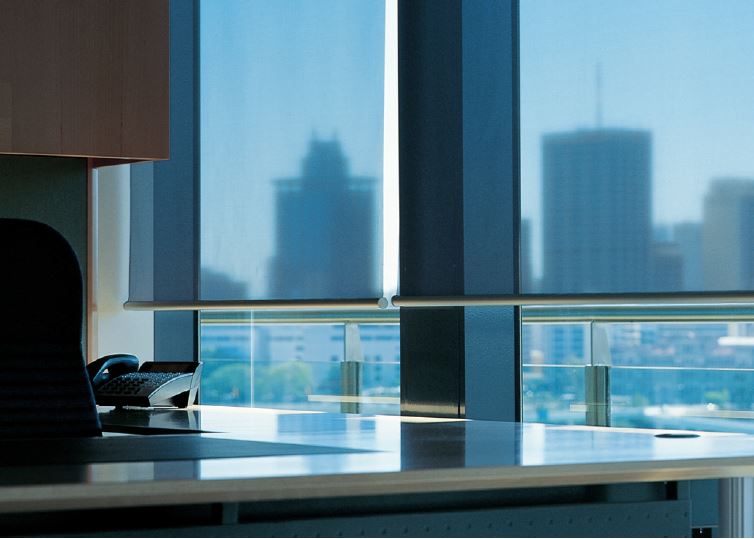Workplaces that are adorned by natural light and expansive views counteract the negative impacts of job stress and positively influence general well-being.
Designers and specifiers should opt for window coverings that are able to maintain view-through and keep natural light levels at a premium.
Over the last few decades, technological changes and new behaviors in the workplace have affected employee productivity and efficiency. With increased daily job demands and an increase in employee responsibilities and autonomy, there has also been an amplified level of workplace stress and time pressures. Not only has this led to increased sickness absence and presenteeism, (which costs the Australian economy about $34 billion annually), but productivity levels in the workplace have also decreased dramatically.
There are various factors that affect employee productivity in the workplace. In 2016, Harvard Business Review reported that physical location has large effects on employee performance. From a design point of view, this can be narrowed down to lighting, ventilation, comfort, and health and wellness. For this reason, this whitepaper will discuss how window coverings can boost workplace productivity and uncover the considerations that architects, designers, and business owners should keep in mind when aiming to boost productivity within the workplace.
Key Factors Affecting Productivity
In early 2018, ABC News stated that most Australian’s spend 90 percent of their time indoors. Accordingly, well-designed indoor environments are essential in ensuring people are well-positioned to be productive and performing at their best. Thinking specifically about the workplace, adequate lighting, well-maintained temperatures, and good ventilation have been proven to be a great motivator for increased levels of productivity. Today, employers are
aware that the workplace environment plays a crucial role in overall employee experience, allowing them to attract,
engage and retain talent.
Adequate Lighting Levels & Maintaining View-Through
Keeping in mind that the physical work environment plays a part in boosting overall employee satisfaction, research suggests that there is a direct correlation between productivity and natural light.
Unlike artificial lighting, natural daylight supports the regulation of Vitamin D, serotonin, and melatonin, which not only reduces levels of absenteeism but also decreases eyestrain and headaches by 51 – 63 percent, thus increasing employee productivity.
As a way to maximize natural light and views surrounding the interior, architects and designers are increasingly specifying floor-to-ceiling windows. While initially chosen, for this reason, large windows often become concealed with blinds and curtains as employees look to combat heat and glare. While heavy blinds and curtains do provide opportunities to save on energy costs, the loss of view through and natural lighting can restrict productivity. As a result, designers and specifiers should opt for window coverings that are able to maintain view-through and keep natural light levels at a premium.
Indeed, workplaces that are adorned by natural light and expansive views counteract the negative impacts of job stress and positively influence general well-being.
Glare
Research indicates that 75 percent of window coverings remain in the same position every day in a bid to reduce glare. In workspaces, glare can occur from undressed windows and incorrectly installed artificial lighting. Defined as the phenomenon caused by extremely bright light sources or strong brightness contrasts in the visual field, glare can often trigger visual discomfort and compel employees to reposition themselves to counter the sun or track light reflections.
With an ever-increasing reliance on digital mediums, glare is becoming a growing factor in workplace environments. With computer screens, phones, and video conferencing the norm in office environments, acceptable daylight luminance levels have been affected. As screen clarity remains a priority, it is important that specific lighting and performance levels are controlled in order to prevent glare and maximize efficient working conditions. Visual comfort is achieved when daylight exposure, view-through, and glare control are in balance.
Comfort & Ease Of Use
The Department of Energy reported13 that smart management of commercial window coverings can reduce heat gain by up to 77 percent – and these same practices can reduce heat loss in the winter. Not relying on air-conditioning or heating systems will also save energy costs and long-term running costs with proper window coverings.
Using window coverings manufactured with the correct materials and colors that can reflect heat from the sun will also allow for a comfortable room temperature. Cornell University conducted an experiment to test commercial employee productivity levels and discovered that overall output increased by 150 percent when thermostats and window coverings were set to the ideal room temperature.
Conclusion
When considering products to specify for any commercial interior, it is possible to specify window coverings that allow natural light in, maintains view through, limit glare, and increase thermal comfort. In Australia, as employees spend more than 40.2 hours a week at work, that environment greatly influences performance and mental framework. To create a productive workplace, designers and architects need to develop a strategy that supports and enables efficient, happier, and healthier employees. This can be done with simple design elements that often get overlooked, like window coverings. A good human-centered design workplace creates flexible and inclusive spaces, allowing for personalization but also comfort.
Download the full whitepaper provided by Verosol here.
Learn more about our commercial shading solutions made for managing daylight effectively here.

